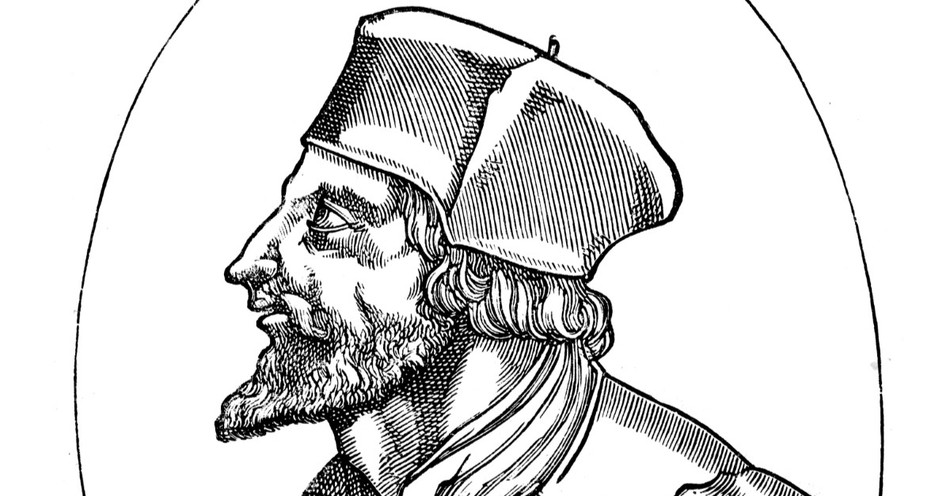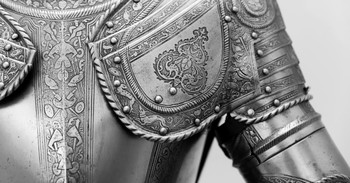Over 500 years after the tragic event, Pope John Paul II came to the homeland of Jan Hus and apologized for the cruel death inflicted on him (see pg. 4). Here is the story behind that sad yet triumphant episode in church history.
Forbidden to Speak
The date was July 6, 1415. The priest who stood alone in the Cathedral of Constance, hands chained in front of him, had a favorite saying, "Truth Conquers." Watching to see if he would stand for truth or flinch were hundreds of churchmen and Sigismund, the Holy Roman Emperor. Noblemen of Bohemia, knights and other witnesses also looked on.
Jan Hus (pronounced Yon Hoos) was about to be ritually stripped of his priestly office. Outside the cathedral, a stake was in preparation at which to "cook the goose." (Hus means "goose" in Czech.)
A list of charges was read, but as Hus tried to answer them, Cardinal Peter D'Ailly ordered him to be quiet. Hus was told that he could reply to all the charges at one time. "And how should I reply to all of them together when I cannot reflect upon them all together?" protested Hus. He continued to try to answer each charge but was told, "Be silent now. We have already heard enough from you!"
"I plead with you, for God's sake, hear me, so that those standing here will not believe that I held such errors. Afterward you can do to me what you like!" cried Jan. But he was forbidden to say anything at all. At this, he fell to his knees and committed his cause to God. A few minutes later he was even rebuked because he had appealed to God!
Alone against Wickedness
Hus was on trial because he was the most vocal champion of reform in the Czech church. For years he had preached to his fellow Czechs in their own language at Bethlehem Chapel, one of only two chapels in the whole nation allowed to offer vernacular sermons. The reforms he called for were not extreme (see below). To some extent, his views were formed by his reading of the works of the English reformer John Wycliffe, but Hus never accepted Wycliffe's most radical demands.
At first, Hus was supported by his archbishop, Zbynek (pronounced Sbiniek) and by mad King Vaclav IV. But Zbynek, who had bought his office, had little scriptural knowledge and soon believed those who said Hus was a heretic. For his part, Vaclav supported Hus only until Hus denounced the methods being used to sell indulgences. Pardons for sins were being hawked shamelessly, and Vaclav wanted his cut of the profits.
Repeatedly accused of heresy, Hus was excommunicated four times, once in violation of church procedure. He appealed and sent spokesmen to represent his true positions, but these messengers were mistreated and even cast into prison.
Sigsmund's False Promise
Two radical reformers, who had gone far beyond Hus, were pressured to recant. They turned on Hus and claimed he taught things he hadn't. To answer these claims and to clear himself, Hus accepted an invitation to present his case at the Council of Constance. Emperor Sigismund guaranteed his safety.
Sigismund's promise proved worthless and he himself would eventually call for Hus' death. As for the churchmen, many were stung by Hus' denunciation of their greed, gluttony, sexual sins and ignorance. Indeed, on the walls of Bethlehem chapel, paintings contrasted the lives of rich proud popes with the humility and poverty of Christ and the apostles. The very council that condemned Hus proved his point. Thousands of churchmen gathered to end a split in the papacy, which saw as many as three popes ruling at once. One of their acts was to imprison Pope John XXIII for a long list of serious crimes, including rape, piracy and murder--while 1,500 prostitutes thronged the town, eager to serve the delegates.
Final Chance to Dodge the Flames
On June 8, Cardinal D'Ailly put a choice to the prisoner. He could cast himself on the mercy of the council, renouncing a list of errors he was alleged to have taught, or he could insist on one more hearing. D'Ailly recommended against Hus requesting another hearing.
Having long taught that one must stand by truth, regardless of the consequences, Hus could not accept the first choice. And his experience with the council showed him that the second option was a sham.
Now, almost a month later, he had his final chance. The council urged him to reject certain heresies that they claimed he had taught. Hus declared that he would gladly root out all heresy if he could be shown from the Bible anything false that he had taught. He flatly refused to pretend he had ever promoted the lies attributed to him.
He prayed aloud for God's forgiveness of the clergymen who had rigged his trial. But those for whom he prayed jeered at him.
Faithful in the Flame
The lonely priest was stripped of the symbols of his office. When they took the cup from him, he declared his hope that Christ would not take the cup of mercy from him. When they committed his soul to the devil, he committed it to Christ.
Outside, they led him to the stake. After kneeling in prayer, he was chained by the neck. Wood was piled around him.
Urged one last time to renounce his errors, he replied that he had never taught the things charged to him. "The principle intention of my preaching and of all my other acts or writings was solely that I might turn men from sin. And in that truth of the Gospel that I wrote, taught, and preached in accordance with the sayings and expositions of the holy doctors, I am willing gladly to die today."
When the fire was lit, the brave reformer began to sing.
The Daring Reformer of Prague
Jerome of Prague was a daring Czech reformer who delighted in taunting the opposition. It was Jerome who had brought Wycliffe's works from England to Prague.
Although he knew the risk he was taking--Hus had already been burned-- he slipped into Constance, supposing he could slip out again. He almost succeeded but was caught before he reached the safety of an international border. When tried by the council, Jerome wavered at first, but eventually stood firm to his beliefs and was condemned. A paper hat with devils painted on it was placed on his head. Like Hus, he was burned.
What Hus Wanted
- Reform of the clergy and papacy
- Preaching in local languages rather than in Latin.
- Testing church teachings by the word of God.
- Administration of the Eucharist as both bread and wine to lay people (who were only allowed the bread).
- Embrace of poverty by the priesthood.
- Obedience of the priesthood to Christ.
- Judgment of Wycliffe's writings and his own by fair standards.
- Reform of the methods by which indulgences were promoted.
Fascinating Facts about Hus
- Bethlehem Chapel in Prague was attacked by Hus' enemies with crossbows, halberds and swords while he preached. They wanted to pull it down, but were foiled.
- Once when Hus was preaching, he recognized a spy planted by Zbynek and called out, "Make a note of this, you sneak, and carry it over there [to the archbishop]."
- At Constance, Hus was imprisoned behind the latrines. The stench was so dreadful that he became sick and almost died.
- After Hus was condemned, Lord John of Chlum, a Bohemian nobleman, shook the reformer's hand in front of everyone. Hus was deeply moved.
- The council believed that it possessed the ultimate authority in the church. Hus believed he must answer to God for his conscience. Neither could compromise without betraying their fundamental beliefs.
A Pope Apologizes
584 years after Hus' cruel death at the hands of the Council of Constance, Pope John Paul II apologized to the Czech people.
Paying tribute to the moral character of Hus, the pope said, "On the eve of the great Jubilee, I feel the need to express a profound regret for the cruel death inflicted on Jan Hus and the consequent wound, the source of conflicts and divisions, which were opened in the spirits and the hearts of the Bohemian people." He called for an end to divisions in the church.
The wound he referred to was the rebellion against the Roman Church, which followed the deaths of Hus and Jerome of Prague. In fierce fighting, during which both sides perpetrated grievous atrocities, the Bohemians, led by their brilliant blind general, Jan Zizka, defeated the powers of Europe in battle after battle. Rome was eventually forced to make concessions to the Bohemian church. To counter the excesses of war, Zizka prepared the Christian world's first known code of military conduct.
© 2006 by Christian History Institute. Prepared by Dan Graves, MSL, with Ken Curtis, PhD, Joe Thomas, PhD, Tracey L. Craig, and Ann T. Snyder.
Resources
1. Domaszewski, Alfred von. Geschichte der romischen kaiser. Leipzig, Quelle & Meyer, 1909. Source of the third page portrait.
2. Dowley, Tim, editor. Eerdman's Handbook to the History of Christianity. Berkhamsted, Herts, England: Lion Publishing, 1977.
3. Fudge, Thomas A. "Hus, Jan." Oxford Encyclopedia of the Reformation. Editor in chief Hans J. Hillerbrand. New York : Oxford University Press, 1996.
4. "Hus, Jan." The Catholic Encyclopedia. New York: Robert Appleton, 1914.
5. Hus, Jan. The Letters of John Hus. Trans. Matthew Spinka. Manchester: Manchester University Press, 1972.
6. "Hus, Jan." New Schaff-Herzog Encyclopedia of Religious Knowledge. Grand Rapids: Baker Book House, 1954.
7. "Hus, Jan." The Oxford Dictionary of the Christian Church. Edited by F. L. Cross and E. A. Livingstone. Oxford, 1997.
8. "Jan Hus, the Incendiary Preacher of Prague." Christian History & Biography. Issue 68. (Vol XIX, No. 4)
9. Lutzow, Count. Life and Times of Master John Hus. London: Dent 1909. Source of the 1st page portrait.
10. "Pope Apologizes for Church's Treatment of John Hus." (www.americamagazine.org/catholicnews.cfm? articleTypeID=29&textID=2024&issueID=261)
11. Spinka, Matthew. Jan Hus at the Council of Constance. New York and London: Columbia University Press, 1965.
12. --------- John Hus and the Czech Reform. Hamden, CT: Archon Books, 1966.
Photo Credit: © Getty Images/duncan1890
This article is part of our People of Christianity catalog that features the stories, meaning, and significance of well-known people from the Bible and history. Here are some of the most popular articles for knowing important figures in Christianity:
How Did the Apostle Paul Die?
Who are the Nicolaitans in Revelation?
Who Was Deborah in the Bible?
Who Was Moses in the Bible?
King Solomon's Story in the Bible
Who Was Lot's Wife in the Bible?
Who Was Jezebel in the Bible?
Who Was the Prodigal Son?



